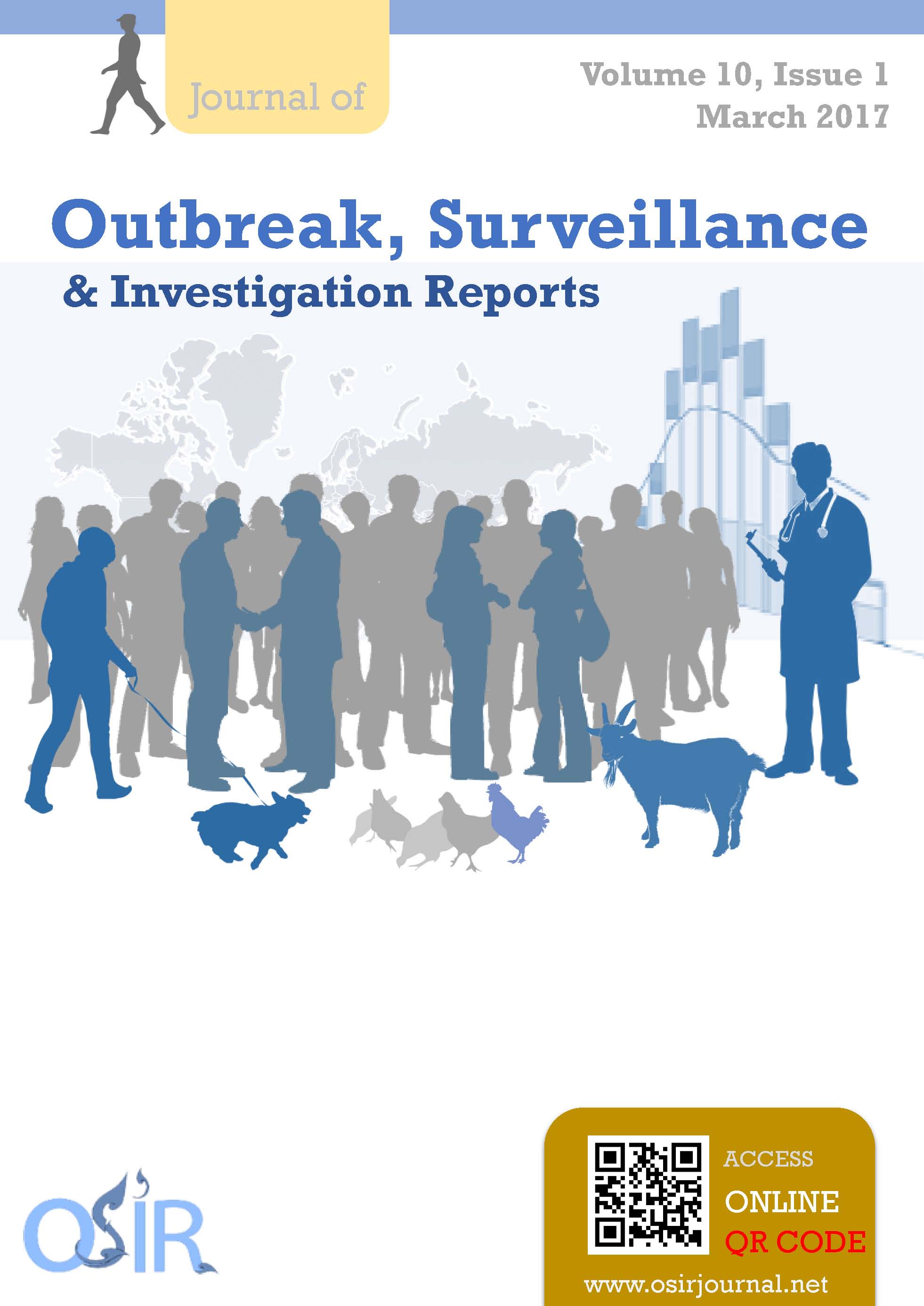Population Attributable Fraction of Stroke Risk Factors in Thailand: Utilization of Non-communicable Disease Surveillance Systems
DOI:
https://doi.org/10.59096/osir.v10i1.263188Keywords:
stroke, Thailand, population attributable fraction, risk factor, behavioral impactAbstract
In Thailand, stroke is the third leading cause of death. The objective of this study was to measure the impacts of behavioral risk and underlying disease factors on stroke. The study design was a case-cohort study comparing prevalence of demographic characteristics and risk factors between stroke patients and general population. We obtained data of stroke patients and risk factors in general population of 12 provinces from two non-communicable disease surveillance systems to calculate population-attributable fraction: the national health information system for morbidity and mortality surveillance, and the behavioral risk factor surveillance system. Multiple logistic regression, based on weighted data and adjusted for clustering effect in each province, was carried out. It was found that approximately 41.6% (95% CI = 35.1-46.2) of stroke in Thai population was related to hypertension. From an age group-specific model, among those aged 15-34 years, smoking carried the highest population attributable fraction of stroke, 32.7% (95% CI = 3.9-40.4). This study demonstrates that impact measurement of stroke risk factors could help devise stroke prevention and control strategies to tackle influential factors. In Thailand, hypertension control program should be a priority in middle and old age groups whereas smoking prevention should be emphasized in young people.
References
Prasad K, Vibha D, Meenakshi. Cerebrovascular disease in South Asia - Part I: A burning problem. JRSM Cardiovasc Dis. 2012 Oct 31;1(7).1-7.
World Health Organization. Global status report on non-communicable diseases 2014. Geneva: World Health Organization, 2014 [cited 2015 Oct 9]. <http://apps.who.int/iris/bitstream/10665/148114/1/9789241564854_eng.pdf>
Thailand. Bureau of Non-communicable Diseases. Department of Disease Control. Ministry of Public Health. Annual report 2015 [cited 2015 Nov 23]. <http://thaincd.com/document/file/download/paper-manual/Annual-report-2015.pdf>
Sacco RL, Benjamin EJ, Broderick JP, Dyken M, Easton DJ, Feinberg WM, et al. Risk factors. Stroke. 1997;28:1507-17.
Park TH, Ko Y, Lee SJ, Lee KB, Lee J, Han MK, et al. Identifying target risk factors using population attributable risks of ischemic stroke by age and sex. J Stroke. 2015 Sep;17(3):302-11.
Razvodovsky YE. Fraction of stroke mortality attributable to alcohol consumption in Russia. Adicciones. 2014;26(2):126-33.
Mirzajani M, Mirzaei M. Population attributable fraction of ischemic heart disease associated to hypertension in the Middle East and North Africa. JCHR. 2015;4(1):38-46.
Lee CM, Huxley RR, Lam TH, Martiniuk AL, Ueshema H, Pan WH, et al. Prevalence of diabetes mellitus and population attributable fractions for coronary heart disease and stroke mortality in the WHO South-East Asia and Western Pacific regions. Asia Pac J Clin Nutr. 2007;16(1):187-92.
Rėklaitienė R, Tamošiūnas A, Domarkienė S, Šopagienė D, Bacevičienė M, Juozulynas A, et al. Prevalence of risk factors, population-attributable fraction and risk of stroke among Kaunas middle aged population. Acta Medica Lituanica. 2006;13(1):47-52.
Ingun P, Narkpaichit C, Boongerd P. Thailand health information system improvement through universal health coverage implementation. Journal of the Thai Medical Informatics Association. 2015;2:137-47 [cited 2015 Oct 9]. <http://tmi.or.th/jtmi/wp-content/uploads/2015/07/4.5-Thailand-Health-Information-System-Improvement-Through-Universal-Health-Coverage-Implementation-Pianghatai-Ingun-Chirod-Narkpaichit-Prasit-Boongerd.pdf>
Centers for Disease Control and Prevention. The BRFSS data user guide. 2013 Aug 15. [cited 2016 Sep 16]. <http://www.cdc.gov/brfss/data_documentation/pdf/userguidejune2013.pdf>
Thailand. Bureau of Non-communicable Diseases. Department of Disease Control. Ministry of Public Health. The survey results of behavioral risk factors of non-communicable diseases and injuries [cited 2016 Jul 28]. <http://www.searo.who.int/entity/noncommunicable_diseases/data/tha_bhv_rsk_survey_2010.pdf>
Zhao J, Pachanee CA, Yiengprugsawan V, Seubsman SA, Sleigh A; Thai Cohort Study Team. Smoking, smoking cessation, and 7-year mortality in a cohort of Thai adults. Popul Health Metr. 2015 Oct 27;13:30.
Suwanwela NC. Stroke epidemiology in Thailand. J Stroke. 2014 Jan;16(1):1-7.
Areechokchai D, Sayumphurujinan S, Saengwanloy S. How the national health information system (43 files) represents the situation of non-communicable diseases: lessons learned from the stroke surveillance in 8 provinces of Thailand, 2014. Weekly Epidemiological Surveillance Report. 2016;47(23):353-9. Thai.
Centers for Disease Control and Prevention. Overview: BRFSS 2014. 2015 Sep [cited 2016 Aug 6]. <http://www.cdc.gov/brfss/annual_data/2014/pdf/overview_2014.pdf>
Porta M, editor. A dictionary of epidemiology. 6th ed. New York: Oxford University Press; 2014.
Rothman KJ, Greenland S, Lash TL. Modern epidemiology. 3rd ed. Philadelphia: Lippincott Williams & Wilkins; 2008.
Harwood RH. The epidemiology of stroke. Brit J Cardiol. 2001;8(9):507-13.
Stegmayr B, Asplund K, Kuulasmaa K, Rajakangas AM, Thorvaldsen P, Tuomilehto J. Stroke incidence and mortality correlated to stroke risk factors in the WHO MONICA Project. An ecological study of 18 populations. Stroke. 1997;28:1367-74.
Population Pyramids of the World from 1950 to 2100. Thailand 2016 [cited 2016 Aug 8]. <https://populationpyramid.net/thailand/>
Imano H, Kitamura A, Sato S, Kiyama M, Ohira T, Yamagishi K, et al. Trends for blood pressure and its contribution to stroke incidence in the middle-aged Japanese population: the circulatory risk in communities study (CIRCS). Stroke. 2009 May;40(5):1571-7. Epub 2009 Apr 2.
Aekplakorn W, Sangthong R, Kessomboon P, Putwatana P, Inthawong R, Taneepanichskul S, et al. Changes in prevalence, awareness, treatment and control of hypertension in Thai population, 2004-2009: Thai National Health Examination Survey III-IV. J Hypertens. 2012 Sep;30(9):1734-42.
Thailand. National Statistical office. Ministry of Information and Communication Technology. Cigarette smoking and drinking behavior survey. 2014 [cited 2016 Aug 8]. <http://web.nso.go.th/en/survey/health/cigareetts_main.htm>
Downloads
Published
How to Cite
Issue
Section
License
Copyright (c) 2023 Outbreak, Surveillance, Investigation & Response (OSIR) Journal

This work is licensed under a Creative Commons Attribution-NonCommercial-NoDerivatives 4.0 International License.









